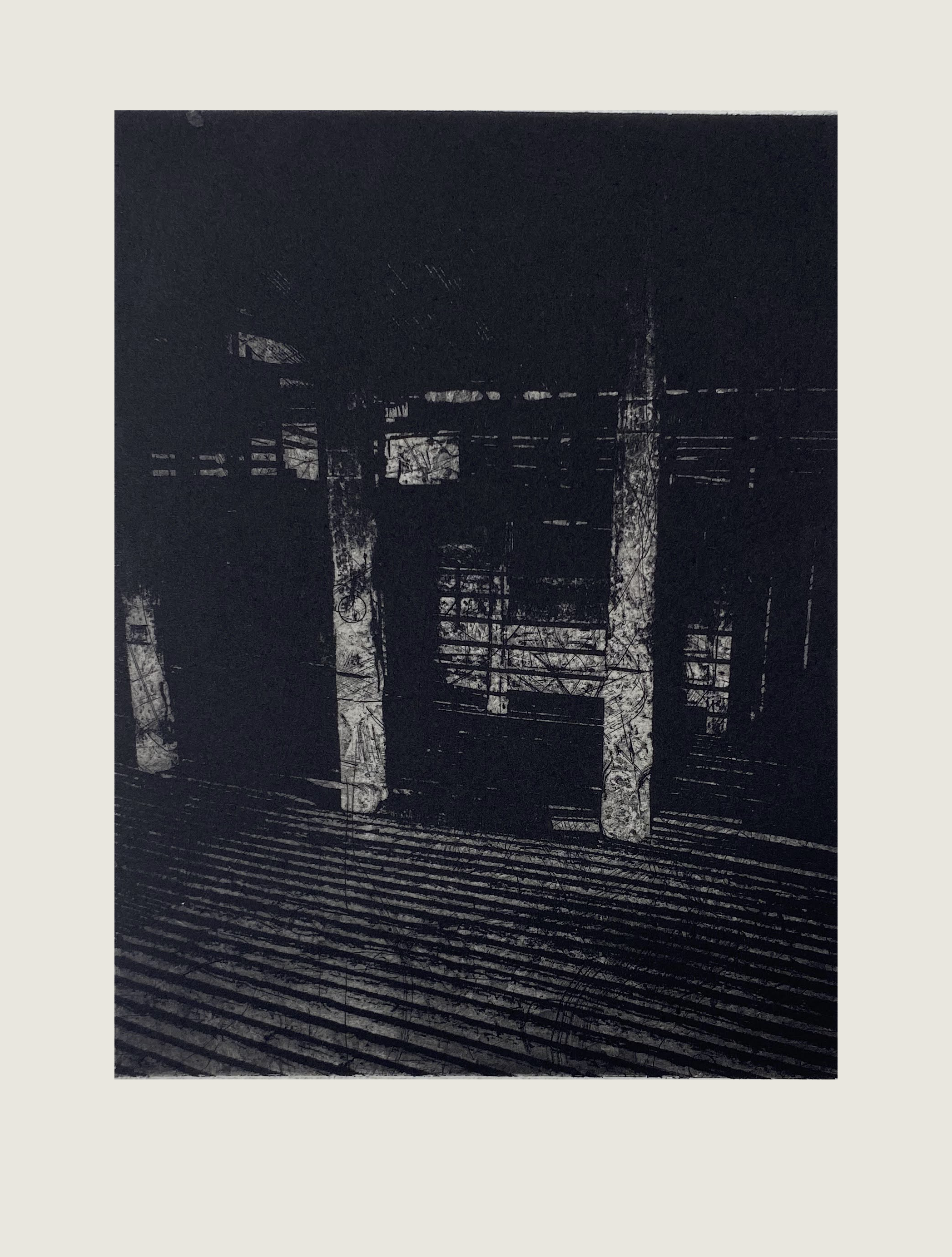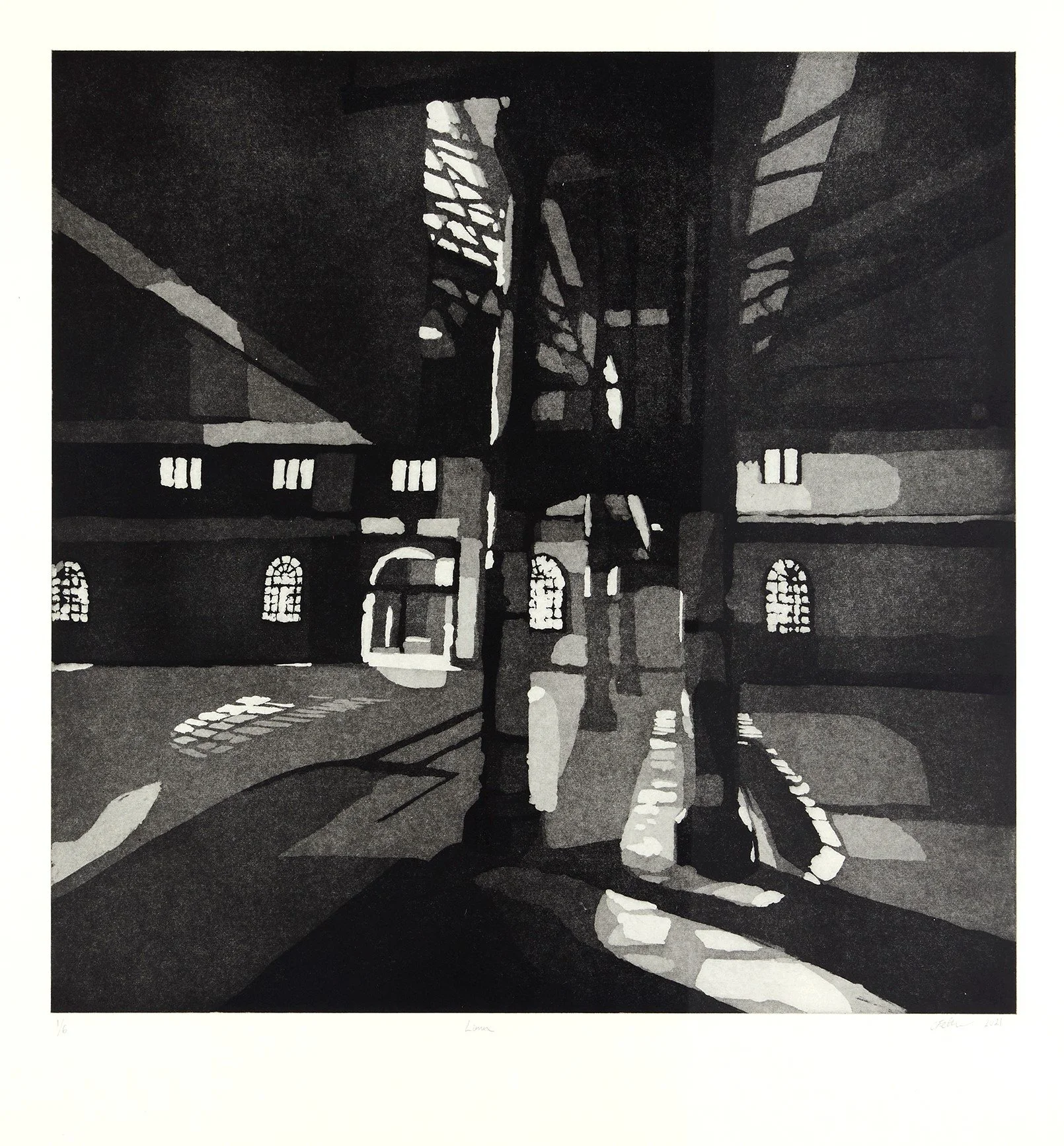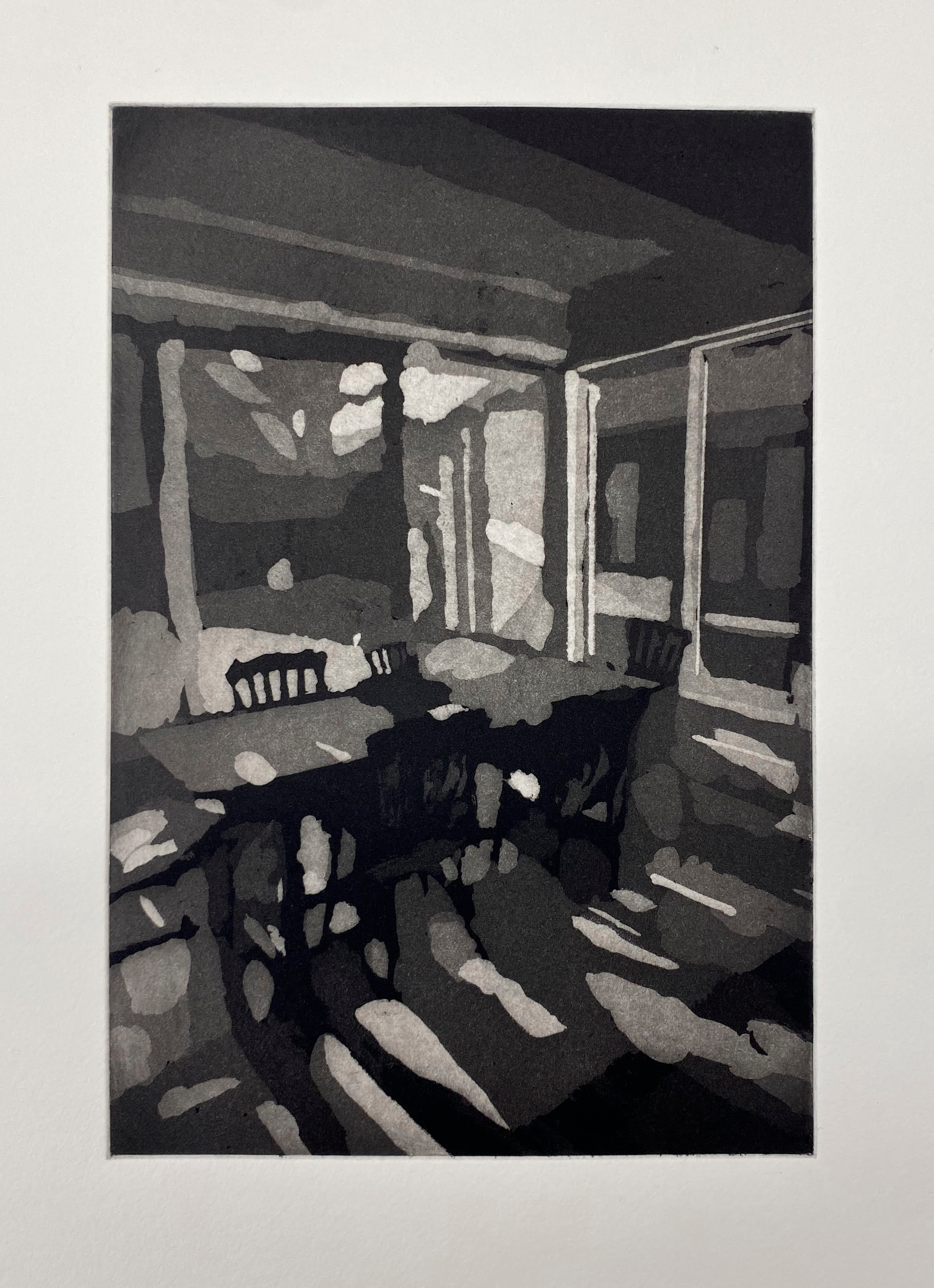Photography by Isabella Kennedy.
Charlotte Fetherston
Charlotte Fetherston (b. 1988, Auckland New Zealand) is a printmaker based in Sydney. Specialising in copper plate etching, Fetherston’s recent work explores how architectural spaces relate to direct and diffused light. To the artist, the play of light on a structure evokes a sense of nostalgia, and aiming to capture this personal and often fleeting sensation visually is the motivation behind her current body of work. Fetherston works primarily with aquatint and uses brushwork to create tonal depth.
Fetherston recently completed a Bachelor of Fine Arts at the National Art School, and has been in group shows at the National Art School, Stella Downer Fine Art and Artsite Galleries, Sydney. She has also been a finalist in the Lloyd Rees Youth Memorial Award and the Waverley Woollahra Printmaking Prize, and has had work acquired by the National Art School. Fetherston performs professionally as a viola player, having studied at the New Zealand School of Music and the Sydney Conservatorium of Music.
Tell us about your creative process, what drives your practice?
I fell into printmaking when I took a chance and enrolled at art school, a few years into my career as a musician. I think what drew me to it as a medium was the tug of war between precision and chance. With printmaking, you can do everything you want to try to execute something in particular, but chemicals, printing environment or just luck will surprise you. As an artist who creates quite traditional prints, I think that musical training definitely plays a part in the outcomes, following old methodology, striving to get that perfectly straight print, seeking a repetitive perfection that comes with editioning. My urge to create art comes from somewhere quite abstract for me. I really just want to portray a fleeting feeling, something unable to be captured in any way but how I’m uncovering it through the process of plate preparation and print trials. My visual starting point for my current work is from snapshots of my world, little snippets of otherwise unobserved life that propel me to recreate them.
Recently you’ve been exploring light within architectural spaces to invoke a sense of nostalgia - can you expand on the interplay between light and memory?
My strongest memories are those associated with light and warmth in buildings or surroundings of my childhood. A couple of years ago I came to the realisation that I tend to notice shifting light on a structure. As I take this in, I allow my mind to create associations. When looking through my collected visual imagery, I realised that the light captured only existed on that day and in that exact location, and it evoked something ineffable. Light is temporal, it allows us to see the world to create images that we then remember emotionally. I chanced upon the writings of Gaston Bachelard in The Poetics of Space which considers the personal relationship we have to the buildings we use and inhabit. Bachelard assigns areas where we nestle our memories, and these places allow us to build our formative personality.
Your works engage with temporal subject matter, which can often be difficult to convey through visual outputs. How has the materiality of aquatint enabled you to capture these elusive subjects?
It occurred to me that my images portray a split second in time via the medium of copper plate etching, which is one of the slowest, most process-driven ways to create art. It seems a bit odd! However creating images through aquatint gives you one an appreciation of light, because you literally have to sit and wait by the acid bath for each layer of light to appear (or rather, for darkness to gather on the plate). I do not use hard lines in my work, everything is painted onto the plate, creating diffused structural boundaries. By simplifying the plate into one ink colour with a range of tones, the viewer needs to piece the shadow together to find form rather than being told what exactly it is. The soft edges of painted aquatint aim to evoke the ephemerality of a memory.
My next project also considers temporality: I am looking at how I can incorporate performing music into sound drawings and prints. Much like the light snapshots, sound too exists only in one moment: it is truly temporal. And, for an added challenge, it is unable to be seen.
Are there any female printmakers | artists that influence you?
Seher Shah, who through drawing, printmaking and sculpture looks at ideas in architecture and perspective, and how humans view the landscape historically and intimately. Rosaire Appel, who looks at connections between reading, looking and listening, particularly finding structures in sound. Katie Paterson, whose work considers humans and geological time, and brings the viewer to ‘the distant edges of the cosmos.’ One brilliant artwork, Earth-Moon-Earth, saw her transmit Beethoven’s Moonlight Sonata to the moon in morse code, which was then received back with information missing. This re-composed sonata is then played through an automated piano. Alicja Kwade, who has an aesthetic similarity to Paterson: her sculptures and installations consider the viewer’s subjectivity of time and space, by using reflection, sounds and doubling to make the viewer question their reality. And finally, Rachel Duckhouse, a drawer and printmaker who uses research based projects to discover rhythms, patterns and structures in landscape, architecture and the other systems.
Finally, what exciting projects are you working on at the moment?
I’ve just had a group show open at Stella Downer Fine Art, and now I am setting up my own plate processing station in my studio. I found getting set up as a printmaker quite a struggle when I left the infrastructure of the university, and so I’ve been thinking about ways that emerging printmakers could help each other in this respect. I am now enjoying the process of doing it all bit by bit and on a non-institution budget - e.g finding the perfect acid bath from Kmart.
I am fortunate to be included in the Australian Galleries Award Show in January 2023 which I am now preparing works for: I am exploring multi-plate and colour printing using à la poupée. I am also about to embark on a year-long mentorship with Wollongong-based artist Riste Andrievski, through the Emergent program at Stella Downer Fine Art. Riste and I will create works for an exhibition at SDFA in November 2023.





